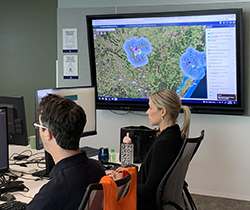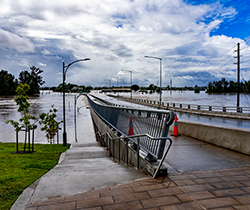Planning and experience aids flood recovery effort
As the sponsor agency for Environmental Services under the NSW Emergency Management Framework, the EPA is once again taking a lead role in emergency response, clean up and recovery for the recent floods across the state.

EPA Incident room staff field calls
Our Director of Incident Management and Environmental Health Arminda Ryan explained that, through our role as Chair of the State Recovery Waste and Environment Subcommittee, we have overseen planning for disaster waste management and are working closely with our colleagues from across government, particularly Public Works Advisory, to ensure the safe and efficient management of flood-generated waste across NSW.
“The experience we gained from responding to the March 2021 floods has meant we’ve been able to provide a much quicker response to these most recent floods. For example, we were able to deploy contractors to clean-up waterways as soon as we saw floodwaters receding enough and it was safe,” Arminda said.
“Beyond waste management, our remit includes conservation recovery (plants and animals) and water quality,” Arminda said.
“Currently, we have staff working full time across the state on our flood response, including over weekends.
“This includes staff from National Parks and Wildlife Service, and Fire and Rescue NSW. We have staff at Recovery Centres and operations officers being deployed to inspect flood damage and environmental controls at temporary emergency waste storage sites.

Windsor Bridge closed during flood
To support the flood response, the EPA has provided regulatory relief for impacted licensees, negotiated waste levy exemptions for flood waste in NSW and Queensland, and released community fact sheets on handling waste, including household chemicals, managing asbestos and interacting with floodwaters safely.
“We are supporting community impacted by leaks from fuel tanks during the flooding, for example tar in homes at South Lismore and diesel fuel in homes at Broadwater,” Arminda said.
“We are also leading the clean-up of waterways and shorelines in flood-impacted areas. Aerial surveillance of rivers and shorelines commenced in mid-March. So far, the contractors have been working in the Hawkesbury, Tweed, Richmond and Wilson rivers and on beaches in the Central Coast and Ballina. And we’ve planned to deploy them to the Hunter and Clarence Rivers in May 2022.
“The location of flood debris was tagged during the flights and specialist marine contractors are tasked with debris collection.”
As of 26 April, over 3240 cubic metres of debris has been removed from the Hawkesbury River and Central Coast beaches and 840 cubic metres from the Tweed, Richmond and Wilson Rivers and Ballina beaches . Debris has included parts of caravans, water tanks, pontoons, drums, plastics, pallets, gas bottles and white goods.

